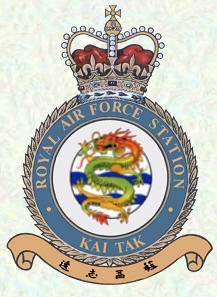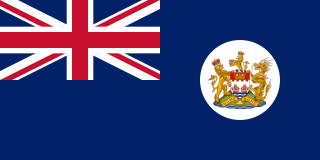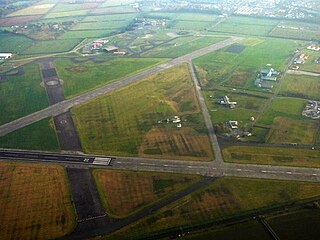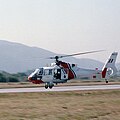
The Army Air Corps (AAC) is the aviation arm of the British Army, first formed in 1942 during the Second World War by grouping the various airborne units of the British Army. Today, there are eight regiments of the AAC, as well as two independent flights and two independent squadrons deployed in support of British Army operations around the world. Regiments and flights are located in the United Kingdom, Kenya, and Canada. Some AAC squadrons provide the air assault elements of 16 Air Assault Brigade, through Joint Helicopter Command.

Royal Naval Air Station Yeovilton, commonly referred to as RNAS Yeovilton, is a military airbase of the Royal Navy, sited a few miles north of Yeovil, in the English county of Somerset. It is one of two active Fleet Air Arm bases, the other being RNAS Culdrose). RNAS Yeovilton is currently home to the Royal Navy Wildcat HMA2, along with Army Air Corps Wildcat AH1 helicopters, as well as the Royal Navy's Commando Helicopter Force Merlin HCi3/4/4A and Wildcat AH1 helicopters.

Royal Air Force Shawbury, otherwise known as RAF Shawbury, is a Royal Air Force station near the village of Shawbury in Shropshire in the West Midlands of England.

RAF Kai Tak was a Royal Air Force (RAF) station in Hong Kong, based at Kai Tak Airport. It was opened in 1927 and used for seaplanes. The RAF flight operated a few land based aircraft as well as having spare aircraft for naval units.

Number 28 Squadron, also known as No. 28 Squadron or No. 28 (AC) Squadron, is a squadron of the Royal Air Force. Based at RAF Benson, it serves as the RAF's Operational Conversion Unit for the Westland Puma HC2 and Boeing Chinook HC5/6/6A helicopters.

British Forces Overseas Hong Kong comprised the elements of the British Army, Royal Navy and Royal Air Force stationed in British Hong Kong. The Governor of Hong Kong also assumed the position of the commander-in-chief of the forces and the Commander British Forces in Hong Kong took charge of the daily deployment of the troops. Much of the British military left prior to the handover of Hong Kong to China in 1997. The present article focuses mainly on the British garrison in Hong Kong in the post Second World War era. For more information concerning the British garrison during the Second World War and earlier, see the Battle of Hong Kong.

Royal Air Force Woodbridge, or more simply RAF Woodbridge, is a former Royal Air Force station located east of Woodbridge in the county of Suffolk, England.

The Hong Kong Aviation Club is an aviation club which offers training on both fixed-wing aircraft and helicopter to Private Pilot Licence Level. It was established in 1982 upon the amalgamation of the Hong Kong Flying Club, the Aero Club of Hong Kong and the Far East Flying Training School.

Royal Air Force Gütersloh, more commonly known as RAF Gütersloh, was a Royal Air Force Germany military airfield, the nearest Royal Air Force airfield to the East/West German border, in the vicinity of the town of Gütersloh. It was constructed by the Germans prior to the Second World War. The station was captured by the Americans in April 1945 and was handed over to the RAF in June 1945 as Headquarters No. 2 Group RAF.

Sha Tin Airfield was a small military airfield in Sha Tin, New Territories, Hong Kong, which had a single concrete runway. The airfield was located along the Shing Mun River and looked out to Tide Cove. The airfield served as a Flight location for most of the location's existence.

Redhill Aerodrome is an operational general aviation aerodrome located 1.5 NM south-east of Redhill, Surrey, England, in green belt land.

Royal Air Force Keevil or more simply RAF Keevil is a former Royal Air Force station lying between the villages of Keevil and Steeple Ashton, about 4 miles (6.4 km) east of the town of Trowbridge, in Wiltshire, England.

Army Aviation Centre (AAC) Middle Wallop is a British Army airfield located near the Hampshire village of Middle Wallop, used for Army Air Corps training. The base hosts 2 (Training) Regiment AAC and 7 (Training) Regiment AAC under the umbrella of the Army Aviation Centre. 2 (Training) Regiment performs ground training; 7 (Training) Regiment trains aircrew on AAC aircraft after they complete basic training at RAF Shawbury.

Miho Airbase (美保飛行場), also known as Yonago Airport is a Japan Air Defense Force (JASDF) base located 11 km northwest of Yonago in Tottori Prefecture. It is owned and operated by JASDF and shares the runway with civil activities.
663 Squadron AAC is a flying unit of the British Army's Army Air Corps (AAC).

Royal Air Force Ballykelly, or more simply RAF Ballykelly, is a former Royal Air Force station which opened in 1941 in Ballykelly, County Londonderry. It closed in 1971 when the site was handed over to the British Army as Shackleton Barracks. A small part of the base has been used as a refuelling point by army helicopters and small fixed-wing aircraft usually operating out of Joint Helicopter Command Flying Station Aldergrove near the town of Antrim.
No. 679 Squadron AAC is a British Army Reserve helicopter support squadron and is part of the 6 Regiment Army Air Corps. The squadron provides groundcrews to support Apache AH1 helicopters.
Hobart Barracks is a former military airfield, located 1.6 km east-northeast of Detmold in North Rhine-Westphalia, Germany.
No. 660 Squadron AAC is a squadron of the British Army's Army Air Corps (AAC). The squadron traces its lineage to a Royal Air Force squadron that existed during the Second World War. In the late 1950s the squadron's numerical was transferred to the AAC and since its formation in 1969, it has operated as a British Army unit flying various types of battlefield helicopters. The squadron has been re-formed and disbanded on a number of occasions. The squadron is currently based at RAF Shawbury where it forms part of No. 1 Flying Training School, but it has been deployed operationally to Northern Ireland, Hong Kong and Brunei throughout its existence.
The following is a hierarchical outline for the British Armed Forces at the end of the Cold War. It is intended to convey the connections and relationships between units and formations.





















